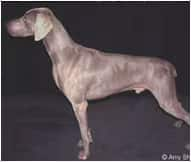About
A Weimaraner is 60-70cm at the shoulder; females are often slightly smaller. Their bodies are strong and built for work, streamlined and able to run with great endurance. The head is strong and hound-like with dropped ears. Weimaraners generally mature at 1 to 2 years, although they reach their full size around 6 to 8 months.
The Weimaraner coat is short, smooth, and sleek and considered "wash and wear;" these dogs require little more than a quick rubdown with a rubber curry brush. The colour is mouse-grey to silver-grey, giving the dog the nickname "the grey Ghost."
|
The Weimaraner coat is short, smooth, and sleek and considered "wash and wear;" these dogs require little more than a quick rubdown with a rubber curry brush. The colour is mouse-grey to silver-grey, giving the dog the nickname "the grey Ghost."
|
Personality
Weimaraners are active dogs, requiring a high level of physical activity given their hunting history. Although they are hunting dogs, they do not make good kennel dogs and prefer being with their owners. They are highly intelligent and need activities to keep them occupied to prevent destructive behaviour such as chewing and digging. They need to be kept in a large fenced-in backyard to prevent them from roaming.
What to Expect
Weimaraners need a large amount of interaction with people. They tolerate other dogs well, if properly socialised. Other pets, such as cats, rodents, birds or reptiles, should be kept away from the Weimaraners; because of the breed's hunting heritage, these dogs are liable to kill such animals.
Weimaraners are ideal for owners who want a large, active dog for hunting, hiking and other outdoor activities. They can make good watchdogs. Weimaraners do not do well left alone for long periods. They can bark excessively or try to escape if left alone for long hours. They are prone to destructive chewing.Weimaraners typically live from 10 to 15 years.
Weimaraners are ideal for owners who want a large, active dog for hunting, hiking and other outdoor activities. They can make good watchdogs. Weimaraners do not do well left alone for long periods. They can bark excessively or try to escape if left alone for long hours. They are prone to destructive chewing.Weimaraners typically live from 10 to 15 years.
History
The Weimaraner appeared in the early 19th century. These dogs belonged to the Nobles of Weimar, who bred the "Weimar pointers" to hunt big game. It is believed that the Bloodhound might be an ancestor or relative of the Weimaraner. Regardless of its origins, the nobles restricted the ownership of the Weimaraner to the membership of the German Weimaraner Club. The Weimaraner was later developed as a bird dog as big game declined in Germany.Howard Knight, an American sportsman and dog breeder, brought two Weimaraners to the United States in 1929. Even before AKC recognition, the Weimaraner performed exceptionally in obedience trials, stirring interest on the part of dog enthusiasts. The Weimaraner was recognised by the American Kennel Club (AKC) in 1943.
The Weimaraner excels in hunting and is a member of the sporting group. This breed makes a delightful, active companion.
The Weimaraner excels in hunting and is a member of the sporting group. This breed makes a delightful, active companion.
Adopt a pet. Change a life.
Are you prepared to adopt a pet? Use these tools to make sure you are ready for the commitment.
Adopt a pet. Change a life.
Are you prepared to adopt a pet? Use these tools to make sure you are ready for the commitment.






















